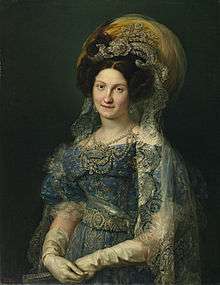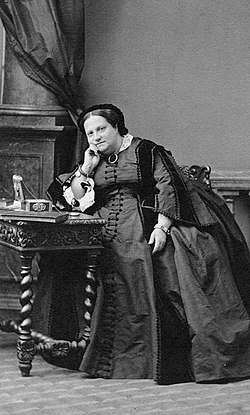Maria Christina of the Two Sicilies
Maria Christina of the Two Sicilies (Italian: Maria Cristina Ferdinanda di Borbone, Principessa delle Due Sicilie, Spanish: María Cristina de Borbón, Princesa de las Dos Sicilias; 27 April 1806 – 22 August 1878) was queen consort of Spain from 1829 to 1833 and regent of the Kingdom from 1833 to 1840.
| Maria Christina of the Two Sicilies | |||||
|---|---|---|---|---|---|
 Portrait by Vicente López y Portaña, 1830 | |||||
| Queen consort of Spain | |||||
| Tenure | 11 December 1829 – 29 September 1833 | ||||
| Born | 27 April 1806 Palermo, Kingdom of Sicily | ||||
| Died | 22 August 1878 (aged 72) Le Havre, French Third Republic | ||||
| Burial | |||||
| Spouse | |||||
| Issue among others... | |||||
| |||||
| House | Bourbon-Two Sicilies | ||||
| Father | Francis I of the Two Sicilies | ||||
| Mother | María Isabella of Spain | ||||
| Religion | Roman Catholicism | ||||
With her marriage to King Ferdinand VII of Spain, Maria Christina became a central character in the history of Spain for 50 years.
Early Life
Born in Palermo, Sicily on 27 April 1806, she was the daughter of King Francis I of the Two Sicilies by his second wife, Maria Isabella of Spain.
Queen of Spain
On 27 May 1829, Maria Josepha Amalia of Saxony, the third wife of King Ferdinand VII of Spain, died. Ferdinand VII, old and ill, had gone his reign without producing a male heir, sparking a succession duel between the Infanta Maria Francisca and the Infante Carlos, and the Infanta Luisa Carlotta and the Infante Francisco de Paula. Ferdinand VII declared his intention to marry and assembled the Council of Castile, who tasked the King with remarriage. Following Luisa Carlotta's suggestion, Ferdinand VII sent for Maria Christina, his niece, who had already given birth to a child and pleased the King's eyes. The two were wed on 12 December 1829 at the Church of the Atocha.[1]
With her betrothal and then marriage to Ferdinand VII, Maria Christina became embroiled in the conflict between the Spanish Liberals and the Carlists. The former faction, and the Spanish people, greatly revered Maria Christina, and made her their champion; when she first arrived in Madrid in 1829, the blue of the cloak she wore became their official color. The latter were absolutists and highly conservative, and derived their name from the Carlos's, who they favored for the throne. Using King Philip V's enactment of Salic law, which banned women from taking the throne, Maria Francisca and Carlos pushed for the latter's claim. Ferdinand VII and Maria Christina produced two daughters, Isabella on 10 October 1830[2] and Luisa Fernanda a little over a year later on 30 January 1832. However, in a secret session of the Cortes in 1789, King Carlos IV reversed this law with the Pragmatic Sanction. Seeking to secure the succession of an heir of his siring, no matter their gender, Ferdinand VII announced the Pragmatic Sanction in March 1830.[3]
In July 1832, Maria Christina, Ferdinand VII, their daughters, Maria Francisca and Carlos, and Maria Teresa, Princess of Beira, set out for the Royal Palace of La Granja. On the trip to La Granja, Ferdinand VII was badly injured by a coach accident. He became ill and increasingly sick over the summer. At one point, Ferdinand VII was found unconscious at the palace chapel. Seeking council in the event of Ferdinand VII's death, Maria approached the Carlist Francisco Calomarde, who advised her that the Spanish people would rally behind Carlos. Acting on this, she coerced Ferdinand VII into signing a decree making her regent if he died, with Carlos as her chief adviser. Carlos refused, demanding total governance. Calomarde, with Maria Francisca and Maria Theresa, reissued his warning, coercing King and Queen into repealing the Pragmatic Sanction. When Ferdinand VII appeared to have died, the repealing was announced publicly, and Maria Christina deserted by her courtiers. Ferdinand VII was discovered to be alive, and news of this also spread. Altogether, Luisa Carlotta, at that time in Andalusia, soon arrived at La Granja and speedily re-enacted the Pragmatic Sanction and orchestrated Calomarde's dismissal.[4]
Regency

When Ferdinand died on 29 September 1833, Maria Christina became regent for their daughter Isabella. Isabella's claim to the throne was disputed by Carlos, who claimed that his brother Ferdinand had unlawfully changed the succession law to permit females to inherit the crown (see Carlism). Some supporters of Don Carlos went so far as to claim that Ferdinand had actually bequeathed the crown to his brother but that Maria Christina had suppressed that fact. It was further alleged that the Queen had signed her dead husband's name to a decree recognizing Isabella as heir.
Carlos' attempt to seize power resulted in the First Carlist War. Despite considerable support for Carlos from conservative elements in Spain, the Cristina's side (also known as "Isabelinos") successfully retained the throne for her daughter.
Downfall
On 28 December 1833, shortly after the death of Ferdinand VII, Maria Christina had secretly married an ex-sergeant from the royal guard, Agustín Fernando Muñoz (1808–1873). Maria Christina and Muñoz had several children together while trying to keep their marriage a secret.[5]
- Maria de los Desamparados, Countess of Vista Alegre (17 November 1834 - 19 August 1864); married Prince Władysław Czartoryski (1828–1894).
- Maria de los Milagros, Marchioness of Castillejo (8 November 1835 – 9 July 1903); married Filippo del Drago, Principe di Mazzano e d'Antuni (1824–1913).
- Agustín Maria, 1st Duke of Tarancón (15 March 1837 - 15 July 1855)
- Fernando Maria, 2nd Duke of Riansares and Tarancon (27 April 1838 – 7 December 1910); married Eladia Bernaldo de Quirós y González de Cienfuegos (1839–1909).
- Maria Cristina, Marchioness of La Isabella (19 April 1840 – 19 December 1921).
- Juan Bautista, Count of Recuerdo (29 August 1841 – 2 April 1863)
- Antonio Muñoz y de Borbón (3 November 1842 – 1847)
- Jose Maria, Count of Gracia (21 December 1843 – 17 December 1863)
Muñoz enlisted in the royal bodyguard, and attracted the attention of Maria Christina. According to one account, he distinguished himself by stopping the runaway horses of her carriage; according to another, he only picked up her handkerchief; a third explanation of his fortune has been given. Maria Christina's husband, King Ferdinand VII of Spain died on 29 September 1833, and on 28 December 1833 she and Muñoz were privately married.
If Maria Christina had officially made the marriage public, she would have forfeited the regency; but her relations with Muñoz were perfectly well known within the Spanish court. When on 13 August 1836 the soldiers on duty at the summer palace La Granja mutinied and forced the regent to grant a constitution, it was generally, though wrongly, believed that they overcame her reluctance by seizing Muñoz, whom they called her guapo, or fancy man, and threatening to shoot him.
Eventually, news of Maria Christina's marriage to this low-ranking soldier became public. That news made Maria Christina deeply unpopular. Her position was undermined by news of her remarriage and concerns that she was not actually supportive of her liberal ministers and their policies. Eventually, the army, which was the backbone of Isabella II's support, and the liberal leadership in the Cortes combined to demand that Maria Christina stand aside from the regency. In 1840 Maria Christina found her position intolerable; she renounced the regency and left Spain with Muñoz. The army commander, General Baldomero Espartero, Count of Luchana, replaced her as regent.
Exile

In 1842 Maria Christina purchased the Château de Malmaison as their residence. In 1843, on the overthrow of General Baldomero Espartero they returned to Spain. In 1844, Muñoz's stepdaughter Queen Isabella II was declared to be of age. On 23 June 1844 Isabella gave to Muñoz the title duque de Riánsares, to which was attached a Grandeza de España;[6] the title came from the river Riánsares, near Muñoz's birthplace in Tarancón. On 12 October 1844 Isabella gave official consent to the marriage between her mother and Muñoz, and it was publicly performed. In 1846 Isabella made Muñoz a Knight of the Golden Fleece. On 30 May 1846 she gave Muñoz a second title, marqués de San Agustín.[6] Muñoz was made a Captain General, the highest rank in the Spanish Army. In 1847 Louis Philippe, King of the French, gave Muñoz the title duc de Montmorot; he also invested Muñoz with the Grand Cross of the Légion d'honneur. In 1854, Maria Christina left for France a second time. France remained her primary residence for the remainder of her life.
Death and burial
Maria Christina's illness returned and she suffered from serious coughing, fainting and fever. She died in Le Havre, France on 22 August 1878. As the mother of Isabella II, Maria Christina was buried in the royal crypt of El Escorial.
Ancestry
| Ancestors of Maria Christina of the Two Sicilies | |||||||||||||||||||||||||||||||||||||||||||||||||||||||||||||||||||||||||||||||||||||||||||||||||||||||||||||||||||||||||||||||||||||||||||||||||||||||||||||||||||||||||||||||||||||||||||||||||||||||||||||||||||||||||||||||||||||||||||||||||||||||||||||||||||||||||||||||||||||||||
|---|---|---|---|---|---|---|---|---|---|---|---|---|---|---|---|---|---|---|---|---|---|---|---|---|---|---|---|---|---|---|---|---|---|---|---|---|---|---|---|---|---|---|---|---|---|---|---|---|---|---|---|---|---|---|---|---|---|---|---|---|---|---|---|---|---|---|---|---|---|---|---|---|---|---|---|---|---|---|---|---|---|---|---|---|---|---|---|---|---|---|---|---|---|---|---|---|---|---|---|---|---|---|---|---|---|---|---|---|---|---|---|---|---|---|---|---|---|---|---|---|---|---|---|---|---|---|---|---|---|---|---|---|---|---|---|---|---|---|---|---|---|---|---|---|---|---|---|---|---|---|---|---|---|---|---|---|---|---|---|---|---|---|---|---|---|---|---|---|---|---|---|---|---|---|---|---|---|---|---|---|---|---|---|---|---|---|---|---|---|---|---|---|---|---|---|---|---|---|---|---|---|---|---|---|---|---|---|---|---|---|---|---|---|---|---|---|---|---|---|---|---|---|---|---|---|---|---|---|---|---|---|---|---|---|---|---|---|---|---|---|---|---|---|---|---|---|---|---|---|---|---|---|---|---|---|---|---|---|---|---|---|---|---|---|---|---|---|---|---|---|---|---|---|---|---|---|---|---|---|---|---|
| |||||||||||||||||||||||||||||||||||||||||||||||||||||||||||||||||||||||||||||||||||||||||||||||||||||||||||||||||||||||||||||||||||||||||||||||||||||||||||||||||||||||||||||||||||||||||||||||||||||||||||||||||||||||||||||||||||||||||||||||||||||||||||||||||||||||||||||||||||||||||
Citation
- Aronson 1966, pp. 6–7, 8.
- Aronson 1966, pp. 8, 9.
- Aronson 1966, pp. 8–10.
- Aronson 1966, pp. 10–12.
- José María Zavala: Bastardos y Borbones: Los hijos desconocidos de la dinastía Retrieved 25 January 2016.
- Elenco de Grandezas y Títulos Nobilarios Españoles. Madrid: Ediciones Hidalguia, 1996; ISBN 84-87204-84-8.
- Genealogie ascendante jusqu'au quatrieme degre inclusivement de tous les Rois et Princes de maisons souveraines de l'Europe actuellement vivans [Genealogy up to the fourth degree inclusive of all the Kings and Princes of sovereign houses of Europe currently living] (in French). Bourdeaux: Frederic Guillaume Birnstiel. 1768. p. 9.
- Chisholm, Hugh, ed. (1911). . Encyclopædia Britannica. 10 (11th ed.). Cambridge University Press.
- Genealogie ascendate, p. 1
- Navarrete Martínez, Esperanza Navarrete Martínez. "María de la O Isabel de Borbón". Diccionario biográfico España (in Spanish). Real Academia de la Historia.
- Genealogie ascendate, p. 96
References
- Aronson, Theo (1966). Royal Vendetta: The Crown of Spain, 1829–1965. Bobbs-Merrill. ISBN 978-1910198117.CS1 maint: ref=harv (link)
- Encyclopædia Britannica
- Two Sicilies family tree at the Wayback Machine (archived March 17, 2006)
- Genealogical information at thepeerage.com
External links
![]()
Maria Christina of the Two Sicilies Cadet branch of the House of Bourbon Born: 27 April 1806 Died: 22 August 1878 | ||
| Spanish royalty | ||
|---|---|---|
| Vacant Title last held by Maria Josepha Amalia of Saxony |
Queen consort of Spain 11 December 1829 – 29 September 1833 |
Vacant Title next held by Francis, Duke of Cádiz |